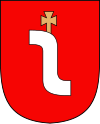
Alternate names: Lesko [Pol], Linsk, לינסק [Yid], Lisko [Pol, until 1926], Ukrainian: Льиско. Russian: Леско. 49°27' N, 22°19' E, 80 miles WSW of L'viv (Lvov), 31 miles SW of Przemyśl, 10 miles SE of Sanok. Jewish population: 2,425 (in 1890). Yizkor: Sefer yizkor; mukdash le-yehudei ha-ayarot she-nispu ba-shoa be-shanim 1939-44, Linsk, Istrik, Beligrod, Litovisk veha-sevivah (Tel Aviv, 1965). Słownik Geograficzny Królestwa Polskiego (1880-1902), V, pp. 313-314: "Lisko". Lesko is a town in SE Poland with a 2008 population of 5,755 in the Bieszczady mountains and in the heartland of the Doły (Pits). Since 2002, the town has been the capital of Lesko powiat in Subcarpathian Voivodeship (since 1999) and previously in Krosno Voivodeship (1975-1998). map. The fortress-like synagogue building remains, currently housing an art gallery. [June 2009]
. "intact and under the care of the Polish cultural ministry in 1967." Source: Cohen, Chester G. "Jewish Cemeteries in Southern Poland" from `An Epilogue' in Shtetl Finder. 1980.
The Jewish cemetery in Lesko is approximately 3.2 hectares with more than 2,000 gravestones. Cemetery archival materials of 1611 mention two peasants selling Lesko Jews "four headlands ... from the pond ...[for] Polish zloty forty", but death dates on matzevot demonstrate that burials were made in the first half of the 16th century. Legend has it that this was the burial place of Sephardic rabbis expelled from Spain and Portugal in the 16th century, but historians do not confirm this hypothesis. The cemetery is located near the synagogue at ul. Słowackiego. Steeply narrow stairs leading up the hill where on the slope of the hill Zalesionego is the oldest part of the cemetery where sandstone slab gravestones date from the first half of the 16th century. Devoid of decoratios with inscriptions of a simple, archaic font, time and weathering left in the vast majority not in their original places. On the left side of the path is a little slanted sandstone block extending toward the top, the oldest preserved matzevot at the cemetery with a Hebrew inscription that says, "You buried the husband, Bojący of God, son of Eliezer Meszulama (blessed memory be fair), on Tuesday of the month tishzri 9 year 309 rachuby." At the top of the hill is the newer part of the cemetery used from the 18th to 20th century with the largest group of about four hundred gravestones from of the 19th century. Despite WW II, the layout of grave rows is clear. Carved matzevot with characteristic Jewish sepulchral art includes crowns, candlesticks, birds, deer, lions, pots and bowls. Two gravestones are covered with large amounts of script. One is the tomb of Menachem Mendel Horowitz, who died on 9 October 1803 and was the rabbi and tzaddik of Rozwadowa, then a resident in Lesko, the father of the famous tzaddik Naftalego Tzwi Horowitz. Near him are the tomb of his father, the Jaakow, and his son Szmuel Szmelka and his grandson and son of Menachem Mendel Szmuel Szmelki and R. Menachem Mendel Chaim the son of Abraham." During WW II, the cemetery was the site of many executions. The Nazis shot a group of about a hundred elderly and sick Jews and then others hiding in the city after liquidation of the ghetto. Symbolic graves memorialize the victims of the Holocaust. In 1969, the cemetery was landmarked. In the 1980s and 1990s, the cemetery was the subject of research by Andrzej Trzcinski and Paul Synowskiego from the University of Maria Curie-Sklodowska Wodzińskiego and Martin from the University of Wroclaw that resulted in the book entitled "Jewish Cemetery in Lesko, containing an inventory of gravestones from the 16th and 17th centuries. Jewish Heritage Protection Foundation and the youth program "Antyschematy" had work done on the cemetery. Photos. "ulica J. Slowackiego, 2000 tombstones. The oldest 1548." [May 2009]
BOOK: Gruber, Ruth Ellen. Jewish Heritage Travel A Guide to East-Central Europe. New York: John Wiley & Sons, Inc., 1992. p. 53
UPDATE: synagogue photo. [August 2005]
UPDATE: Cemetery photos [January 2006]
LESKO: US Commission No. POCE000727
Lesko is in Krosno at 49º28 22º20, 14 km from Sanok and 55 km from Krosno. Cemetery location: Slowackiego St. Present town population is 5,000-25,000 with no Jews.
- Town: Urzad Miasta i Gminy, Pazkowa 1, 38-600 Lesko, tel. 615, telex: 65502.
- Regional: Wojewodzki Konserwator Zabytkow mgr. Alojzy Cabala, ul. Bieszcradzka 1, 38-400 Krosno, tel. 21-974.
The earliest known Jewish community was 16th century. 1921 Jewish population was 2,400. The landmarked Orthodox Jewish cemetery was established in 16th century. Landmarked The isolated urban crown of a hill has an inscription in Hebrew on the gate or wall. Reached by turning directly off a public road, access is open to all. A masonry wall with a locking gate surrounds. The size of the cemetery before WWII and now is 3.0 hectares. 500-5000 gravestones, 20-100 not in original locations with 25%-50% toppled or broken, date from 1548-20th century. The marble, granite, sandstone, and concrete finely smoothed and inscribed stones, flat stones with carved relief decoration, double tombstones, or sculpted monuments have Hebrew and Polish inscriptions. Some tombstones have traces of painting on their surfaces. No mass graves. The municipality owns site used as a Jewish cemetery only. Properties adjacent are residential. Frequently, private visitors and local residents visit. The cemetery was vandalized occasionally. Local/municipal authorities cleared vegetation and fixed gate in 1991. Occasionally, authorities clear and clean. There are no structures. Erosion and vegetation are moderate threats.
Piotr Antoniak, ul. Dobra 5 m 36, 05-800 Pruszkow visited site 9 Aug 1992 and completed survey on 9 Sept 1992.
[UPDATE] Photos by Charles Burns [March 2016]
Photo from Facebook [August 2016]

